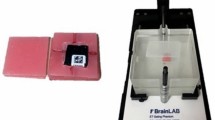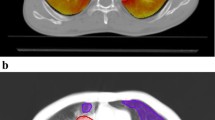Abstract
To design a range-compensating bolus for heavy-charged-particle radiotherapy of lung cancer, we propose an image-processing method that uses CT projection data for treatment planning. We studied six lung cancer patients in 4DCT mode. Three types of range-compensating bolus were designed with use of (1) each bolus for 4DCT images, (2) image-based maximum-intensity projection data (4DIM), and (3) CT images reconstructed by the use of maximum-attenuation projection data (4DPM) along the time axis around exhale (=respiratory-gated treatment). Carbon-ion dose distributions were calculated by the use of these designed range-compensating boluses and were compared. The dose distribution with 4DIM caused overdosing beyond the target. However, the dose distribution with 4DPM was similar to that with a composite of the range-compensating bolus (CCB) designed for the respiratory phases. Furthermore, the volume of the receiving dose for >95% (D95) for CTV and the volume of the lung receiving dose for >20 GyE (V20) with 4DPM were similar to that with the CCB. The range-compensating bolus with 4DPM provides dose distributions similar to that with the CCB in peripheral lung cancer and improves the calculating efficiency over CCB.







Similar content being viewed by others
References
Endo M, Koyama-Ito H, Minohara S, Miyahara N, Tomura H, Kanai T, et al. HIPLAN—a heavy ion treatment planning system at HIMAC. J Jpn Soc Ther Radol Oncol. 1996;8:231–8.
Minohara S, Kanai T, Endo M, Noda K, Kanazawa M. Respiratory gated irradiation system for heavy-ion radiotherapy. Int J Radiat Oncol Biol Phys. 2000;47:1097–103.
Kanai T, Kawachi H, Matsuzawa H, Inada T. Broad beam three dimensional irradiation for proton radiotherapy. Med Phys. 1983;10:344–6.
Futami Y, Kanai T, Fujita M, Tomura A, Higashi N, Matsufuji N, et al. Broad-beam three-dimensional irradiation system for heavy-ion radiotherapy a HIMAC. Nucl Instrum Methods Phys Res A. 1999;430:143–53.
Kanematsu N, Endo M, Futami Y, Kanai T, Asakura H, Oka H, et al. Treatment planning of the layer-stacking irradiation system for three-dimensional conformal heavy-ion radiotherapy. Med Phys. 2002;29:2823–9.
Kanai T, Kanematsu N, Minohara S, Komori M, Torikoshi M, Asakura H, et al. Commissioning of a conformal irradiation system for heavy-ion radiotherapy using a layer-stacking method. Med Phys. 2006;33:2989–97.
International Commision on Radiation Units and Measurement. Prescribing, recording and reporting photon beam therapy (supplement to ICRU report 50). ICRU report 62. 1999.
Underberg RWM, Lagerwaard FJ, Slotman BJ, Cuijpers JP, Senan S. Use of maximum intensity projection (MIP) for target volume generation in 4DCT scans for lung cancer. Int J Radiat Oncol Biol Phys. 2005;63:253–60.
Kang Y, Zhang X, Chang JY, Wang H, Wei X, Liao Z, et al. 4D proton treatment planning strategy for mobile lung tumors. Int J Radiat Oncol Biol Phys. 2007;67:906–14.
Mori S, Wolfgang J, Lu H, Schneider R, Choi NC, Chen GY. Quantitative assessment of range fluctuations in charged particle lung irradiation. Int J Radiat Oncol Biol Phys. 2008;70:253–61.
Mori S, Wu Z, Folkert MR, Kumagai M, Dobashi S, Sugane T, Baba M. Practical approaches to four-dimensional heavy-charged-particle lung therapy. Radiol Phys Technol. 2010. doi:10.1007/s12194-009-0072-3.
Mori S, Kanematsu N, Asakura H, Endo M. Projection-data based temporal maximum attenuation computed tomography: determination of internal target volume for lung cancer against intra-fraction motion. Phys Med Biol. 2007;52:1027–38.
Endo M, Mori S, Tsunoo T, Kandatsu S, Tanada S, Aradate H, et al. Development and performance evaluation of the first model of 4-D CT-scanner. IEEE Trans Nucl Sci. 2003;50:1667–71.
Mori S, Endo M, Tsunoo T, Kandatsu S, Tanada S, Aradate H, et al. Physical performance evaluation of a 256-slice CT-scanner for four-dimensional imaging. Med Phys. 2004;31:1348–56.
Author information
Authors and Affiliations
Corresponding author
About this article
Cite this article
Asakura, H., Kumagai, M., Kanematsu, N. et al. A treatment planning strategy for heavy-charged-particle radiotherapy of lung cancer by the use of computed tomography with projection data-based temporal maximum-intensity projection. Radiol Phys Technol 3, 58–64 (2010). https://doi.org/10.1007/s12194-009-0077-y
Received:
Revised:
Accepted:
Published:
Issue Date:
DOI: https://doi.org/10.1007/s12194-009-0077-y




